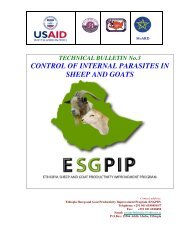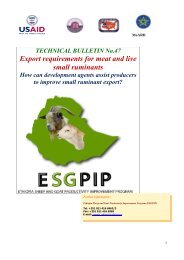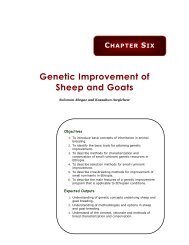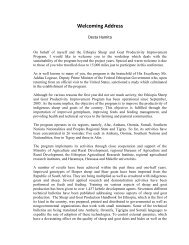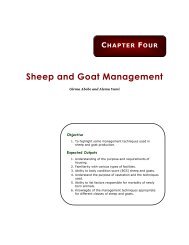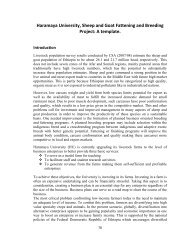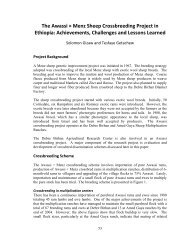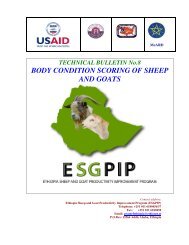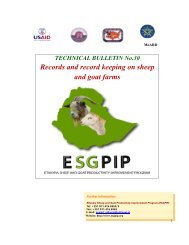GIVING INJECTIONS TO SHEEP AND GOATS - esgpip
GIVING INJECTIONS TO SHEEP AND GOATS - esgpip
GIVING INJECTIONS TO SHEEP AND GOATS - esgpip
You also want an ePaper? Increase the reach of your titles
YUMPU automatically turns print PDFs into web optimized ePapers that Google loves.
MoARD<br />
TECHNICAL BULLETIN No.10<br />
<strong>GIVING</strong> <strong>INJECTIONS</strong> <strong>TO</strong> <strong>SHEEP</strong> <strong>AND</strong><br />
<strong>GOATS</strong><br />
Contact address:<br />
Ethiopia Sheep and Goat Productivity Improvement Program (ESGPIP)<br />
Telephone: +251 011 6180456/57<br />
Fax: +251 011 6180458<br />
Email: pvamrfethiopia@ethionet.et<br />
P.O.Box: 15566 Addis Ababa, Ethiopia
FOREWORD<br />
This Technical Bulletin titled “giving injections to sheep and goats” is the tenth in a series<br />
produced by the Ethiopia Sheep and Goat Productivity Improvement Program (ESGPIP). The<br />
ESGPIP is a USAID funded Project with the objective of improving the productivity of Ethiopian<br />
sheep and goats.<br />
The administration of medicaments in a proper and prescribed manner is important to optimize<br />
the effect of medication and also to minimize damage to tissue of the animal and carcass quality.<br />
This Technical Bulletin is intended to serve as an extension aid for animal health professionals at<br />
the grass roots level that are authorized to provide treatment to animals. The information<br />
contained in this Technical Bulletin is also relevant to other higher health professionals and also<br />
administration of medication to other types of farm animals.<br />
At this juncture, I would like to thank all those involved in the preparation and review of this<br />
technical Bulletin.<br />
Desta Hamito (Prof.)<br />
Chief of Party<br />
ESGPIP<br />
i
TABLE OF CONTENTS<br />
FOREWORD .................................................................................................................................................I<br />
TABLE OF CONTENTS ............................................................................................................................ II<br />
<strong>GIVING</strong> <strong>INJECTIONS</strong> <strong>TO</strong> <strong>SHEEP</strong> <strong>AND</strong> <strong>GOATS</strong> .................................................................................. 1<br />
1. INTRODUCTION ................................................................................................................................ 1<br />
2. DOSAGE ............................................................................................................................................... 1<br />
2.1. DOSE CALCULATION ...................................................................................................................... 1<br />
3. PROPER EQUIPMENT ...................................................................................................................... 2<br />
4. PREPARING THE SYRINGE............................................................................................................ 2<br />
5. CARE OF SYRINGE <strong>AND</strong> NEEDLES.............................................................................................. 3<br />
6. PROPER INJECTION SITES ............................................................................................................ 4<br />
7. COMMON INJECTION METHODS ................................................................................................ 4<br />
7.1. SUBCUTANEOUS <strong>INJECTIONS</strong> ......................................................................................................... 4<br />
7.2. INTRAMUSCULAR ........................................................................................................................... 5<br />
7.3. INTRAVENOUS ................................................................................................................................ 5<br />
8. SUMMARY........................................................................................................................................... 6<br />
ii
<strong>GIVING</strong> <strong>INJECTIONS</strong> <strong>TO</strong> <strong>SHEEP</strong> <strong>AND</strong> <strong>GOATS</strong><br />
Prepared by: Sileshi Zewdie<br />
Edited by: Alemu Yami, L. Dawson and R.C. Merkel<br />
1. Introduction<br />
Administering drugs via injection is a common herd health procedure but one that must<br />
be done correctly to reduce the chance of injury or formation of injection site lesions and<br />
to prevent infection of animals. Use proper equipment and procedures to deliver the<br />
correct medicine dosage and volume at each injection site. Giving injections properly<br />
will minimize animal stress. Proper sanitation will ensure that you don’t inject vaccines<br />
or antibiotics contaminated with bacteria into your sheep or goat that can cause severe<br />
infection. Dirty needles and syringes should never be used.<br />
2. Dosage<br />
If drugs are used incorrectly, disease organisms can build up resistance making drugs<br />
ineffective. This usually happens from underdosing or overdosing drugs. It is best to<br />
calculate the correct dosage based upon the weight of each animal determined by using a<br />
scale or estimated by using heartgirth measurement. In some situations, such as group<br />
treatment, the dosage is estimated based on the weight of the heaviest animal or the<br />
average weight of the flock. In these cases, some animals will be overdosed and some<br />
underdosed.<br />
2.1. Dose calculation<br />
Dosage should be calculated according to the manufacturers recommendations based on<br />
the weight of the animal. The following example shows the steps needed to calculate the<br />
correct dosage.<br />
An animal is estimated to weigh 50 kg.<br />
The manufacturer recommends 10 mg/kg bodyweight of oxytetracycline.<br />
Multiply the animal’s weight, 50 kg, by the dose rate (10 mg/kg) to calculate<br />
the amount of drug required. In this example, 500 mg of oxytetracycline. (50<br />
kg x 10 mg/kg = 500 mg).<br />
Calculate the amount of injectable solution required. The bottle label states<br />
that the injectable solution contains 50 mg/ml of oxytetracycline (which<br />
means that 50 mg of actual medicine is available in each ml of the solution).<br />
Divide the amount of actual medicine the animal needs (500 mg) by the<br />
strength of the medicine (50 mg/ ml) to find that the animal needs 10 ml of<br />
medicine (500 mg divided by 50 mg/ ml = 10 ml of injectable solution).<br />
10 ml of the oxytetracyline injectable solution is needed to provide 500 mg of<br />
actual drug.<br />
1
3. Proper equipment<br />
Proper injection technique includes selection of an appropriate size syringe and needle.<br />
Common syringe sizes are 3 ml, 5 ml, 10 ml, and 20 ml. The syringe should have<br />
volume markers that ensure administration of the correct amount of drug. It is best to use<br />
a syringe that has an appropriate volume to correctly measure the drug. For example, if<br />
giving 2.8 ml of a drug, a 3 ml syringe will measure the amount more accurately than a<br />
20 ml syringe.<br />
Needle length and gauge should be considered as it relates to injection type and thickness<br />
or viscosity of drug. In general, 18 to 20 gauge needles (as gauge number increases,<br />
needle diameter decreases), 12 or 15 mm in length are sufficient.<br />
Figure 1. Different size needles and syringes.<br />
Photo used with permission from the Meat Goat Production<br />
Handbook, Langston University, 2007.<br />
Recommended needle sizes used in sheep and goats<br />
Age<br />
Gauge<br />
< 4 weeks old 20<br />
4 to 16 weeks 20<br />
4 to 6 months 20<br />
> 6 months 18 to 20<br />
4. Preparing the syringe<br />
• Always check the recommended dose on the medicine bottle label and ensure that<br />
your calculations are correct.<br />
• Assemble the syringe and needle.<br />
2
• Shake the medicine bottle, and swab the cap with clean surgical spirit or 70% alcohol.<br />
• Draw a volume of air into the syringe slightly more than the volume of liquid to be<br />
withdrawn.<br />
• Thrust the needle through the rubber cap of the bottle.<br />
• Turn the bottle upside down and push the plunger to inject a couple ml of air into the<br />
bottle (you will have difficulty withdrawing the dose if you do not do this).<br />
• Make sure that the needle tip is below the surface of the fluid.<br />
• Pull the plunger down, drawing slightly more liquid into the syringe than required.<br />
• Push the plunger slightly to expel any air bubbles and adjust to the correct dose.<br />
• Detach the syringe, leaving the needle in the cap for next dose withdrawal.<br />
Finally, attach a second needle to the syringe and expel any air from the needle.<br />
• Needles should be changed between every 5 - 10 sheep/goats. If a blood-borne<br />
disease is suspected in the flock, a new needle must be used with each animal.<br />
• Never use dirty syringes or needles.<br />
• Some medicines must be kept cold or out of the sunlight to remain effective. Bottles<br />
should be stored in a cooler in the shade. Return the bottles to the cooler after<br />
drawing medicine into the syringe.<br />
Figure 2. Filling a syringe with medicine.<br />
5. Care of syringe and needles<br />
• Immediately after use the syringe should be dismantled, thoroughly cleansed, and<br />
then sterilized by boiling in clean water for twenty minutes.<br />
• Always discard partly-used bottles of medicine at the end of the day.<br />
• Do not inject animals within four weeks of slaughter.<br />
• Never vaccinate animals in wet conditions. Wet fleece carries a greater risk of<br />
infection.<br />
3
6. Proper injection sites<br />
All animals are considered as food animals and injections done in ways to prevent<br />
injection site lesions from damaging meat. Injection site defects are lesions or scars found<br />
in cuts of meat that result from tissue irritation caused by the administration of<br />
intramuscular or sometimes subcutaneous injections. In addition to the scarred tissue,<br />
tenderness of the meat is also significantly reduced in the affected area surrounding the<br />
site. Injection site lesions are a major product quality concern for the export market. All<br />
injections should be given in the neck area and no injections should be given in the hind<br />
quarters or along the loin muscle.<br />
7. Common injection methods<br />
The three most common injection methods are subcutaneous (SC, under the skin),<br />
intramuscular (IM, in the muscle), and intravenous (IV, into a blood vessel, usually the<br />
jugular vein). Subcutaneous injections are the easiest to give and intravenous the most<br />
difficult. Whenever a drug or vaccine lists SC as an option for injection use the SC route.<br />
Only experienced personnel should attempt to give an intravenous injection and<br />
professional assistance should be used in most instances. Intravenous injections provide<br />
the fastest absorption of a drug by the animal while subcutaneous the slowest.<br />
7.1. Subcutaneous injections<br />
Subcutaneous injections are given under the skin using a short needle, 1 - 2.5 cm long.<br />
To inject subcutaneously:<br />
o Pull up a pinch of skin making a tent.<br />
o Insert the needle into the tent taking care not to pierce through the other side.<br />
o Depress the plunger slowly.<br />
o Injecting with the needle pointing towards the ground will lessen the likelihood of<br />
the drug leaking out of the hole left by the needle.<br />
o Massage the injected area.<br />
o If administering large amounts of a drug, over 3 ml, it is best to divide the dose<br />
among two or more sites not giving more than 2 or 3 ml per site.<br />
The preferred site for SC injections is<br />
the skin just behind the elbow,<br />
although they can also be given in the<br />
triangular area in front of the shoulders<br />
between the top and bottom of the<br />
shoulder blade and corner of the jaw.<br />
Vaccines often cause swellings or<br />
“knots” and a knot behind the elbow<br />
indicates an injection site whereas a<br />
knot in the neck in front of the<br />
shoulder could possibly be confused<br />
with a caseous lymphadenitis abscess.<br />
Figure 3. Tenting procedure for subcutaneous injection.<br />
Photo used with permission from the Meat Goat Production<br />
Handbook, Langston University, 2007.<br />
4
Don’t inject in red area!<br />
Intramuscular<br />
Subcutaneous<br />
Figure 4. Proper sites for subcutaneous and intramuscular injections.<br />
Illustrations used with permission from the Meat Goat Production Handbook, Langston University, 2007. Drawings by K.<br />
Williams.<br />
7.2. Intramuscular<br />
Intramuscular injections are the most common injection method and require the needle to<br />
be inserted into a muscle. Intramuscular injections are commonly given in the triangular<br />
area of the neck, in front of the shoulder. Do not give intramuscular injections in the loin<br />
or hind leg of sheep and goats that are used for meat to prevent injection site blemishes<br />
that lower the value of the meat. Never give an injection near the spine to prevent<br />
accidentally causing nerve damage. Use an 18-gauge needle, 2-3 cm long, to inject<br />
antibiotics. In small, young lambs and young goats a smaller 20-gauge needle should be<br />
used. Volume given in the muscle should not be more than 3 ml per site.<br />
o To give an injection:<br />
o Gently tap/hit the muscle two or three times with your fist to accustom the<br />
sheep/goat.<br />
o Insert the needle quickly, straight into the muscle.<br />
o Before injecting, draw the plunger out slightly to check if the needle has<br />
entered a blood vessel. If blood enters the syringe, withdraw the needle<br />
slightly and redirect into the muscle.<br />
o When a correct spot has been entered, slowly press the plunger down.<br />
o Remove the needle from the animal and rub the injection site or press with<br />
cotton to prevent excess bleeding. This will also help the medicine to stay<br />
in the muscle.<br />
7.3. Intravenous<br />
An intravenous injection requires skill to locate a vein, usually the jugular vein in the<br />
neck, insert the needle, and ensure that the needle remains in the vessel while<br />
5
the drug is given. These injections should<br />
always be given by a veterinarian or<br />
experienced animal health technician. Animals<br />
may react quickly to drugs given in this fashion<br />
due to rapid absorption. Very few drugs need to<br />
be given intravenously; however, blood samples<br />
often need to be collected and the technique is<br />
the same. Intravenous injections are usually<br />
done using an 18 or 20 gauge hypodermic<br />
needle.<br />
To give an intravenous injection:<br />
o Have someone straddle the goat to hold<br />
it securely.<br />
o The holder should elevate the goat’s<br />
o<br />
o<br />
o<br />
o<br />
o<br />
head up and to the side.<br />
Feel for the trachea on the neck. The<br />
area between the trachea and the muscles of the neck is the “jugular groove” and<br />
is where the jugular vein lies.<br />
Put pressure at the bottom of the groove and you will see the groove swell from<br />
your finger up to the jaw of the goat. The vein is now filled with blood.<br />
Using an 18 to 20 gauge needle, direct it at a 45 degree angle then stab through<br />
the skin.<br />
Pull back on your syringe and see if there is blood present. If not, adjust the depth<br />
(deeper or more shallow) or move up or down the side of the groove until blood is<br />
obtained. The presence of blood signifies that the needle is inside the vein.<br />
Administer drugs slowly and monitor the animal for evidence of respiratory or<br />
cardiac distress. If there is any adverse reaction to the injection, it should be<br />
stopped.<br />
When you are injecting drugs IV, it is important to ensure that all of the drug enters the<br />
vein. The jugular vein will take the administered drug straight to the heart and at high<br />
concentrations many drugs can cause heart problems. IV drugs given around the vein<br />
instead of in the vein can cause an irritation or inflammation of the vein.<br />
8. Summary<br />
Figure 5. Proper site for intravenous injection<br />
Illustration used with permission from the Meat<br />
Goat Production Handbook, Langston University,<br />
2007. Drawing by K. Williams.<br />
All animals will require injections, such as vaccines or antibiotics. Proper dosage,<br />
equipment, and technique are essential to prevent drug resistance, minimize animal stress<br />
and prevent injection site lesions. Drug labels should be read to determine the correct<br />
amount of medicine to give and to correctly calculate dosage of the injectable solution.<br />
Proper syringe and needle sizes will ensure the correct amount of drug given in an<br />
effective manner. The three main types of injections are subcutaneous (SC, under the<br />
skin), intramuscular (IM, in the muscle) and intravenous (IV, in the vein). Only<br />
experienced animal technicians or veterinarians should give intravenous injections. All<br />
SC and IM injections should be given in front of the point of the shoulder or under the<br />
6
skin behind the front leg. Injections should never be given in the hind muscle, shoulder<br />
muscle or the loin. This will prevent injection site lesions from occurring in the most<br />
valuable cuts of meat. Always consult an animal health office before administering drugs<br />
and injections.<br />
References<br />
Dawson, L., J. Allen and B. Olcott. 2007. Meat Goat Herd Health Procedures and<br />
Prevention. In: T.A. Gipson, R.C. Merkel, K. Williams and T. Sahlu (eds.). Meat Goat<br />
Production Handbook. Langston University. 65-96 pp.<br />
7



